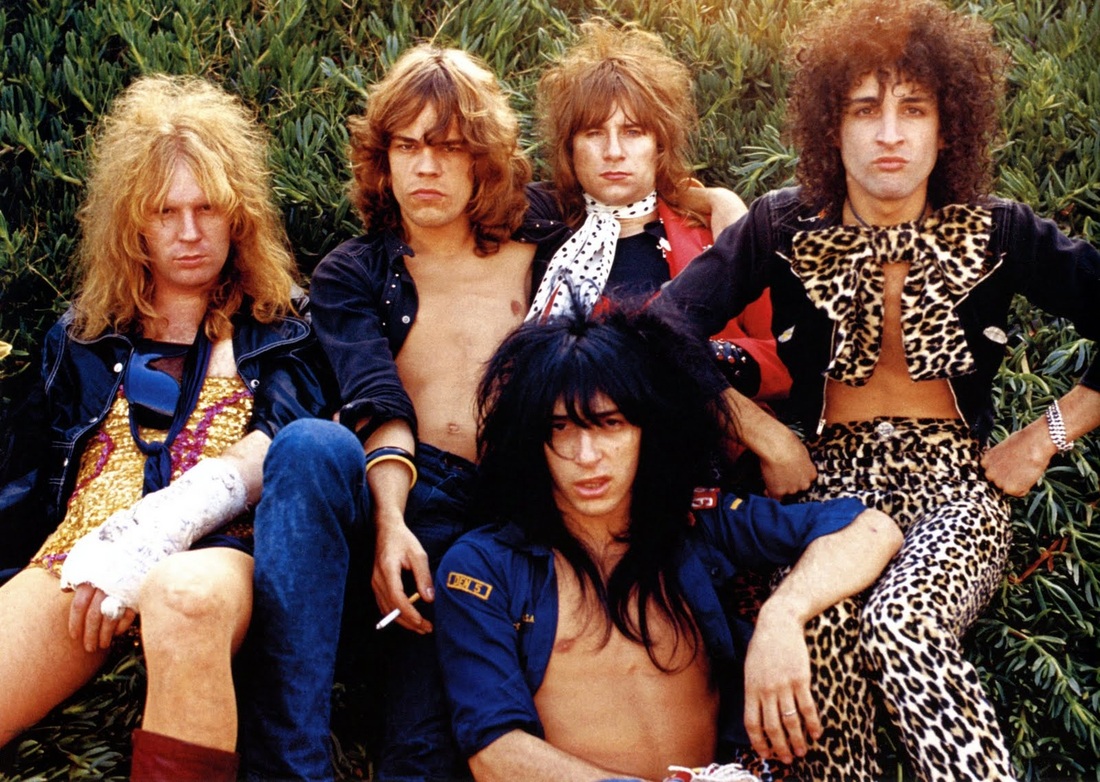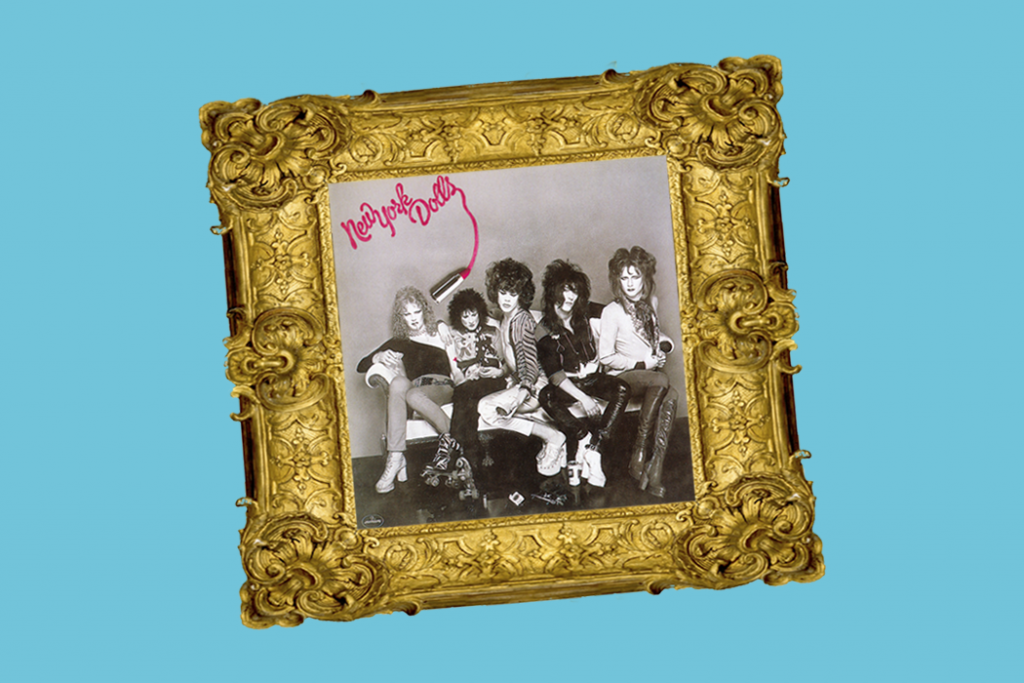+ Our brand new course with The Dillinger Escape Plan’s Ben Weinman teaches how to make a living in music without making sacrifices. Check out The Business of Uncompromising Art, out now exclusively on Soundfly.
New York Dolls – New York Dolls
Release Date: July 27, 1973
“The New York Dolls are the new Rolling Stones.”
–The Village Voice, 1972
On November 6, 1972, after the New York Dolls played a sold-out show with Faces at Wembley Stadium, drummer and songwriter Billy Murcia “succumbed to what is usually referred to as an ‘accidental overdose.’”¹ At a party in a London apartment, Murcia mixed heroin and an excessive amount of alcohol until he began to OD. His girlfriend tried to revive him by putting him into a bath of cold water and forcing him to drink black coffee, but this only resulted in his asphyxiation.
Murcia would never see his twenty-second birthday, and the New York Dolls lost one of their founding members before they ever recorded a single song.
Most of us have never heard Billy Murcia’s drumming — New York Dolls, the New York Dolls’ self-titled debut album, was recorded and released in 1973 — yet his influence on the band’s sound is undeniable. His straightforward technique allowed the band to write simple songs that were both thought-provoking and great to party to. Their shows were legendary, and they quickly became one the most exciting and talked-about bands in New York City during the early ’70s.
In a 1972 article, The Village Voice said, “Dolls are the best New York City band in a decade. Dolls are kings of the scene; Dolls are young; Dolls are a consciousness-raising band; Dolls’ scene is nice, friendly, a phenomenon infinitely more pleasurable than the uptight muttering about the sum of its parts.” From their crazy shows to even crazier outfits, New York was going crazy over the New York Dolls.
Comparisons between the New York Dolls and the Rolling Stones were inevitable. Bill Mann of The Montreal Gazette wrote, “I remember back in 1964 when the Rolling Stones were…dismissed…as ‘just a bunch of fags.’ Well, here it is, 1974, and that’s exactly what people are still saying about the New York Dolls.” Amid stories of sexual debauchery, drug use, and serious alcohol abuse, Mercury Records signed the band to cut a record.
Mercury was understandably nervous about the band’s ability to perform in the studio, so the label hired Todd Rundgren, legendary producer of the Band, Meatloaf, Grand Funk Railroad, etc., to reign in the band and hone their sound. Rundgren was known for his work in pop music, while the Dolls were known to be sloppy, sleazy, and shrill.
“It’s a job.” – Jerry Nolan (drummer)
Yet, the Dolls did also manage to establish themselves as professionals — just drunk and high professionals. “We want to make a buck. We want to make a living and a future,” replacement drummer Jerry Nolan said in an interview with The Beaver County Times in 1974. “We’re entertainers. We’re the hosts, we’ll entertain you.”
The New York Dolls were a professional party band, but that’s not to say they didn’t write lyrically dense songs, like “Vietnamese Baby,” for instance. They knew, however, that when they played a show, they were there to bring the house down and get people moving.
Bassist Arthur Kane echoed this sentiment. “We care nothing about technicalities. We don’t wear our instruments in a holster. This is strictly party, and don’t bother coming if you want to get involved.”
Forty years of scrutiny and commentary can build up an intellectual film over any album. I’m not saying that the New York Dolls are vapid, but they weren’t lofty musicians who wrote Zeppelin-esque odes to Tolkien either. The “Dolls write disposable songs with completely disposable lyrics — the best kind of rock and roll,”³ and that was just their selling point.
+ Learn more on Soundfly: Discover the history, legacy, and musical forms influenced by the blues in our free course, A Conversation with the Blues.
“Are you accusing me of having melody?” – David Johansen (lead vocals)
While Mercury Records had every bit of confidence in Todd Rundgren, they decided to bring in Jack Douglas to help merge his sound with the Dolls’. “Whereas I was always part of the whole Max’s Kansas City downtown crowd, hanging out with all the artists, Todd was more of an uptown kind of guy, more pop, more polished,” Douglas said. “So I think the label decided to balance things out, and since the guys in the band already knew me, they’d have someone they could relate to.”²

Jack Douglas was the perfect link between the raw power of the New York Dolls and the razor-sharp pop sensibilities of Todd Rundgren. Douglas said:
“There was nothing else like the Dolls at the time, which was really cool. It was about playing with complete abandon and being as shocking as you possibly can. That was part of the Alice [Cooper] thing, but with a New York twist — transsexual, transvestite. It was really a downtown, New York-street kind of feel. David was an artist and a writer and an actor, and he had a lot to do with how everything looked and felt. His lyrics were great — they still are — and putting that amount of literacy into that package is what made it so good and appealing. I got that right away; I totally got it, but I don’t think anybody else quite did. They thought, ‘Oh, this is really shocking, it’s gonna be cool,’ but it was way, way deeper than that.”
Douglas’ ability to bridge the gaps between Rundgren and the band wasn’t only limited to ideas. He was also able to elicit powerful performances from a band who had never set foot in a recording studio before. Everything was foreign to the Dolls, including working with headphones, trying to keep a tempo without speeding out of control, and not making horrendous mistakes in the middle of a take — it was a totally new experience².
In other words, they weren’t professional musicians, but they now had to make a professional record. This came with a whole slew of issues, according to Douglas:
“Johnny never played the same thing twice. Sometimes, playing with the rhythm section, he just got the feel, and he nailed it. At other times, he would stop playing because he knew he wasn’t going to get into it, and he’d want to redo it later. Suddenly, he’d be in the control room with me. Then, when he overdubbed his leads, I would do four or five tracks and just comp them like a vocal. He was totally, totally unpredictable, and that’s how he was in life.”
David Johansen was proud of his non-polished howls. During a vocal take for “Gimme a Kiss,” Rundgren told him, “Man, that’s going to be so good with a lot of harmony.” David said, “Harmony? Are you accusing me of having melody?”
“The music rocks out, and maybe they don’t understand the words. That’s why it’s good to have the record out so they can hear the words.” – Arthur Kane (bass)
The New York Dolls’ debut record carried their wild fashion, buzzsaw music, and powerful ideas all over America and England. Their influence became immediately apparent all the way to Los Angeles where the rockers all of a sudden dressed “in bright satin with outrageous ties and hats… The Sunset Boulevard discotheques are trying to drival [sic] the Dolls and their followers in outrageous fashions.”5
They were one of the first punk bands. The release of their debut album undoubtedly influenced countless future punks, including most of the Class of ‘77 (The Damned, X-Ray Specs, Sex Pistols, the Clash, the Ramones, etc.).

Todd Rundgren and Jack Douglas elicited top-notch performances from the band. Billboard magazine called the album, “One of the best solid rock sets to come along in a long time, featuring raunchy lead vocals, tight harmony backup, and excellent instrumental skills.” They were on Cream’s “Best Bands of the Year” list (and their “Worst Band of the Year” list). The New York Dolls were a bonafide national success.
While the band eventually disbanded in the late ’70s due to tensions surrounding interpersonal issues and drug use, their first album continues to be a watershed moment in music history. New York Dolls has since been ranked #213 on Rolling Stone‘s list of the “500 Greatest Albums of All Time,” while the same magazine placed “Personality Crisis” at #267 of its “500 Greatest Songs of All Time.”
Rev Up Your Creative Engines…
Continue your learning with hundreds of lessons on songwriting, mixing, recording and production, composing, beat making, and more on Soundfly, with artist-led courses by Kimbra, RJD2, Com Truise, Kiefer, Ryan Lott, and Ben Weinman’s The Business of Uncompromising Art.
—
Bibliography
- Nusser, Richard. “Once more, death in threes.” The Village Voice [New York City] 16 Nov. 1972: 52. Web. 1 July 2017.
- Buskin, Richard. “New York Dolls ‘Personality Crisis’-Classic Tracks.” Sound on Sound. N.p., 2 Dec. 2009. Web. 1 July 2017.
- Mann, Bill. “New York Dolls music a blast.” The Montreal Gazette. 30 Sept. 1974: 30. Web. 2 July 2017.
- Carr, Patrick. “The Dolls: Get it while you can.” The Village Voice [New York City] 28 Dec. 1972: 28-29. Web. 1 July 2017.
- “The New York Dolls: ‘More Than A Band’” Beaver County Times. 20 Feb. 1974: 24-25. Web. 1 July 2017.




